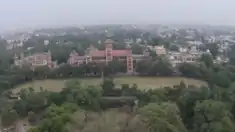Chunni Lal Khetrapal | |
|---|---|
| Born | 25 August 1937 |
| Died | 21 July 2021 (aged 83) |
| Nationality | Indian |
| Alma mater |
|
| Known for | Studies on Nuclear magnetic resonance spectroscopy |
| Awards |
|
| Scientific career | |
| Fields | |
| Institutions |
|
Chunni Lal Khetrapal (25 August 1937 – 21 July 2021) was an Indian chemical physicist and a vice chancellor of the Allahabad University.[1] He was known for his studies in chemical physics, particularly in the field of Nuclear magnetic resonance spectroscopy.[2] He was an elected fellow of the Indian National Science Academy[3] and the National Academy of Sciences, India.[4] The Council of Scientific and Industrial Research, the apex agency of the Government of India for scientific research, awarded him the Shanti Swarup Bhatnagar Prize for Science and Technology, one of the highest Indian science awards, in 1982, for his contributions to chemical sciences.[5]
Biography

C. L. Khetrapal, born on 25 August 1937 in the Indian state of Uttar Pradesh, did his college studies at the Allahabad University from where he graduated in 1957 and completed his master's degree in 1959.[6] He started his career by joining the Atomic Energy Establishment Training School, Mumbai the same year, simultaneously doing his doctoral research at Mumbai University to secure a PhD in 1965. In between, he worked at the Tata Institute of Fundamental Research for a while and moved to Switzerland where he did his post-doctoral studies at the University of Basel from 1967 till 1969. Then he shifted his base to the US to work at the Liquid Crystal Institute of Kent State University as a research assistant. He returned to India in 1973 and joined the Raman Research Institute as an assistant professor where he spent over eleven years till his move to the Indian Institute of Science as a professor and the head of the Sophisticated Instruments Facility in 1984. On his superannuation from service in 1998, he was appointed the vice chancellor of the Allahabad University.[1] When his tenure ended in 2001, he joined the Sanjay Gandhi Postgraduate Institute of Medical Sciences as a distinguished professor for a five-year term (2001–06) and also held the directorship of Centre of Biomedical Magnetic Resonance, Lucknow, an autonomous research centre of the Government of Uttar Pradesh. In between, he had two stints at the National Institutes of Health as a visiting scientist during 1979–80 and in 1984.[3]
Legacy
Using nuclear magnetic resonance spectroscopy (NMR), Khetrapal studied the molecular orientation in the nematic phase of liquid crystals, the non-planar distortions in peptides in the liquid phase and weak molecular interactions involved in hydrogen bonding.[7] Apart from pioneering NMR studies in India, he established the Institute of Interdisciplinary Studies and the Institute of Professional Studies at Allahabad University.[3] His contributions are also reported to be behind the establishment of the National Centre on NMR in Bangalore. He has published a number of articles and books, besides contributing chapters to books published by others including the 8-volume Encyclopedia of Nuclear Magnetic Resonance.[8] He was one of the founders of the National Magnetic Resonance Society and the Centre of Biomedical Magnetic Resonance and served as the first president of the former and was an incumbent director of the latter.[3]
Awards and honors
The Council of Scientific and Industrial Research awarded Deb the Shanti Swarup Bhatnagar Prize, one of the highest Indian science awards, in 1982.[9] He is also a recipient of the C. V. Raman Award of the University Grants Commission of India (1996), Goyal Prize (1996), P. C. Ray Memorial Medal of the Indian Science Congress Association (2002) and the Lifetime Achievement Award of the Indian Chemical Society (2005).[3] He has delivered several award orations including the R. K. Asundi Memorial Lecture Award of the Indian National Science Academy in 1990[10] and N. R. Dhar Memorial Lecture Award of National Academy of Sciences, India in 2005.[11] He was an elected fellow of the Indian National Science Academy and the National Academy of Sciences, India.[4]
See also
References
- 1 2 "Former vice chancellors". Allahabad University. 2016.
- ↑ "Brief Profile of the Awardee". Shanti Swarup Bhatnagar Prize. 2016. Retrieved 12 November 2016.
- 1 2 3 4 5 "Indian fellow". Indian National Science Academy. 2016. Archived from the original on 6 March 2021. Retrieved 19 November 2016.
- 1 2 "NASI fellows". National Academy of Sciences, India. 2016. Archived from the original on 15 March 2016. Retrieved 12 November 2016.
- ↑ "View Bhatnagar Awardees". Shanti Swarup Bhatnagar Prize. 2016. Retrieved 12 November 2016.
- ↑ "Director profile" (PDF). Centre of Biomedical Magnetic Resonance. 2016.
- ↑ "Handbook of Shanti Swarup Bhatnagar Prize Winners" (PDF). Council of Scientific and Industrial Research. 1999. p. 34. Archived from the original (PDF) on 4 March 2016. Retrieved 5 October 2016.
- ↑ Robin K. , Grant; D.M. Harris, eds. (1996). Encyclopedia of Nuclear Magnetic Resonance. John Wiley & Sons. ISBN 978-0471938712.
- ↑ "Chemical Sciences". Council of Scientific and Industrial Research. 2016. Archived from the original on 12 September 2012. Retrieved 7 November 2016.
- ↑ "R. K. Asundi Memorial Lecture Award". Indian National Science Academy. 2016. Archived from the original on 16 September 2016. Retrieved 19 November 2016.
- ↑ "N. R. Dhar Memorial Lecture Award". National Academy of Sciences, India. 2016. Archived from the original on 13 April 2015. Retrieved 19 November 2016.